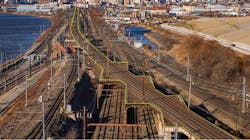FRA publishes Environmental Assessment of Northeast Corridor’s Sawtooth Bridges project
The Federal Railroad Administration (FRA) published the Environmental Assessment of the Sawtooth Bridges Replacement Project, which aims to replace two aging bridges that carry Amtrak’s Northeast Corridor (NEC) trains over New Jersey Transit, Port Authority Trans-Hudson Corporation (PATH) and Conrail tracks.
The Sawtooth Bridges were built in 1907 and are a key component to the Gateway Program. Project partners note that this segment of the NEC has limited efficiency and reliability due to the age and structural condition of the bridges, which carry a speed restriction of 60 mph. To improve the reliability and resiliency of rail service on this segment of the NEC, Amtrak is proposing a replacement of the existing bridges with a 1.1-mile segment that would accommodate four tracks with improved design speeds of 90 mph.
Amtrak’s preferred alternative for the project calls for the construction of two new tracks and associated viaduct structures to the north of the existing Sawtooth Bridges (referred to as the Sawtooth Bridge North) while the existing bridges and tracks remain in service. Once construction of the new tracks is complete, Amtrak would move service from the existing bridges onto the new Sawtooth Bridge North and demolish the existing bridges. Amtrak would then construct a new bridge with two tracks along the existing alignment (referred to as the Sawtooth Bridge South).
Comments on the Environmental Assessment will be taken through April 4, 2020.
In response to the publication of the Environmental Assessment, New Jersey Transit (NJ Transit) President and CEO Kevin Corbett and Amtrak Chief Operating and Commercial Officer Stephen Gardner issued a joint statement:
Amtrak and NJ Transit applaud the U.S. Department of Transportation (USDOT) for publishing the Environmental Assessment for replacement of the Sawtooth Bridges.
The Sawtooth Bridges carry the Northeast Corridor over PATH and Conrail tracks as well as NJ Transit’s busy Morris & Essex Line to Hoboken. These critical spans were built in 1907 and are in urgent need of replacement and expansion, which will increase reliability and ultimately assist in eliminating a major bottleneck in the busiest section of the Northeast Corridor.
We appreciate the ongoing support of our elected leaders and look forward to continuing our work with USDOT and all stakeholders to move this important project forward.
About the Author

Mischa Wanek-Libman
Group Editorial Director
Mischa Wanek-Libman is director of communications with Transdev North America. She has more than 20 years of experience working in the transportation industry covering construction projects, engineering challenges, transit and rail operations and best practices.
Wanek-Libman has held top editorial positions at freight rail and public transportation business-to-business publications including as editor-in-chief and editorial director of Mass Transit from 2018-2024. She has been recognized for editorial excellence through her individual work, as well as for collaborative content.
She is an active member of the American Public Transportation Association's Marketing and Communications Committee and served 14 years as a Board Observer on the National Railroad Construction and Maintenance Association (NRC) Board of Directors.
She is a graduate of Drake University in Des Moines, Iowa, where she earned a Bachelor of Arts degree in Journalism and Mass Communication.
